Okay, so I must admit the thought of baking and cooking with something I have always considered a perfume can be a bit daunting but with lavender being the trendy new culinary herb, I thought why not be a bit venturesome. But can I use just any lavender for culinary purposes? To find out, I paid a visit to The Five Sisters of Lavender Lane – aptly named because there are five sisters involved with the growing, harvesting, and production of the lavender products.
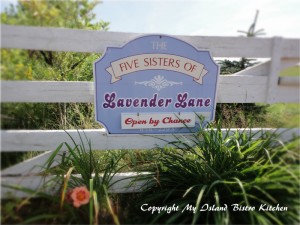
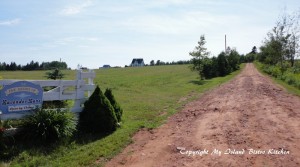
Through the scenic rolling hills of Kelly’s Cross in rural PEI, on the Island’s South side, I find PEI’s only lavender farm. In 1999, Carol Cook bought the farm and, in 2001, planted her first 100 lavender plants to see how they would ‘weather the winter’ on the Island. They did well and, today, there are over an estimated 3000 plants of two varieties (Hidcote and Munstead) grown on the farm.

Carol tells me that starting lavender from seed is not necessarily a guarantee of success. Instead, her preference is to start new plants by propagating from cuttings. This is where a long stem of lavender attached to the mother plant is buried under some soil and left to grow its own roots. The following year it can be cut from the mother plant and, voila, a new lavender plant is started. Another option is to take a cutting from a plant, cut it on an angle, dip it in a root boost starter product, and place it in a sandy soil mixture to take root.
Most of us know lavender as a perfume and potpourri product. However, lavender is actually an herb of the mint family and certain varieties of it are known as culinary herbs. These are primarily the Hidcote and Munstead varieties. Lavender is often considered to be similar to thyme, rosemary, and sage and it can, in fact, be substituted for rosemary in many recipes. If you have ever cooked with Herbes de Provence, chances are you have already tasted lavender since it is a common ingredient in this herb mix along with the typical mixture of thyme, rosemary, and savory.
Lavender is one of the more aromatic herbs and some say it bears citrus notes or even a hint of pine. The lavender buds (the stage just before the plants blossom into full open flower) possess a higher oil content and have the most intense taste. They tend to have a stronger, minty flavour and, when used in cooking or baking will be more pungent and have “more bite” to them. When crushed or ground, the lavender buds have a sweeter, milder flavour. While the leaves, stems, buds, and flowers can all be used for culinary purposes, the flower buds are said to give the most flavour.
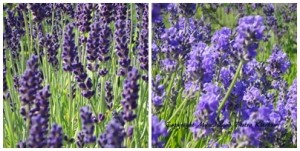
In PEI, harvesting of lavender occurs in mid-July. When at their bud stage, the beautiful purple/mauve buds are removed from their tall spikes, washed, and spread on screens to dry. They are then ready to be used in various products. It is possible to get a second, smaller harvest from the same plants late in August or early September. The photographs below were taken at the lavender farm on July 10, 2012, the day before they began harvesting. I can only imagine the wonderful scent there must have been during the harvesting process!
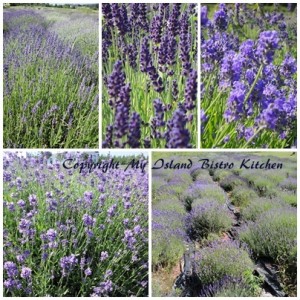
The Five Sisters of Lavender Lane only sell their culinary lavender in the small gift shop at their farm in Kelly’s Cross and it is not uncommon for local chefs to stop by to pick up their supply for their restaurants. If you are cooking with lavender, just make sure that it is the culinary variety you are using and that it has been grown organically, pesticide-free. Besides the culinary lavender, the farm also produces and sells a number of other lavender products onsite including perfumed products. This year, they are currently experimenting with the production of lavender extract which can be used in culinary products in the same way that vanilla, almond, or lemon extract is used.
Lavender is a strong herb so my advice is less is more and to exercise caution in the amount you use in a recipe. If you use too much, it will not be a pleasant taste because it may seem like you are eating soap or that you used perfume in the dish. I find a lot of recipes call for 1-2 tablespoons of lavender and that is way too excessive in any recipe for my taste. When trying a recipe with lavender, I start with a very modest amount and, if I find it is not enough, I will slightly increase the amount the next time I make the recipe until I get it to the point that it pleases my palette. Like any herb, you want it to accent the dish, not predominate and overpower it. Rule of thumb is that, if you are using dried lavender, use one-half what you would use fresh. Because it is not very pleasant to bite into a whole lavender bud, the herb is often ground in a spice grinder or coffee grinder. It is very important to carefully read a recipe that calls for lavender to determine when the amount of the herb the recipe calls for gets measured – i.e., is it before or after the lavender is ground or crushed. If the recipe calls, for example, for 1 tsp. lavender buds finely ground, first measure the whole buds as the teaspoon measure and then grind them as, otherwise, the flavour will be too strong if you were to use 1 tsp finely ground lavender in the recipe.
Lavender is now the trendy herb not only in baked goods like cookies, scones, and sweet breads but in ice cream, in vinaigrettes, in rice, on chicken and lamb, in jams, jellies, and honey, and in drinks such as herbal teas and lemonade. I have done a lot of experimenting with cooking and baking with lavender this summer and I am lucky because I live not far from the lavender farm where I can get my supply of quality culinary lavender. Not long ago, I prepared an evening tea featuring lavender – a Lavender Blueberry Banana Bread, lavender scones with homemade lemon curd, and Swedish Teacakes filled with the curd.
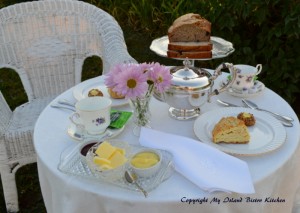
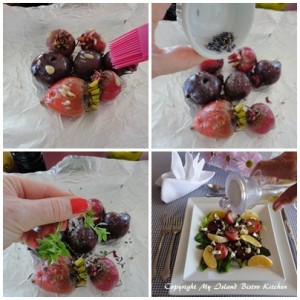
On Sunday evening I made an entire meal with lavender as the focus. For the salad course, I started with a roasted beet and goat cheese salad on garden greens. To roast the beets, I coated them with olive oil then sprinkled some fresh thyme, lemon verbena, basil, dried lavender buds, and a bit of minced garlic on them. I wrapped the beets in tin foil and roasted them at 400C for about 1 hour, till they were fork tender. I then sliced the beets and laid them on a bed of lettuce freshly picked from our garden, added some orange sections, and tossed some goat cheese and pecans on the top. I made a simple citrus-based vinaigrette to drizzle over the salad. The beets had a nice roasted flavour to them, not strong in any herb flavour, which is the taste I was aiming for.
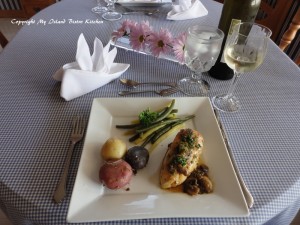
For the main course, I chose a recipe from Sharon Shipley’s “The Lavender Cookbook” for Lavender Chicken Breasts in Champagne Sauce. This was delicious. The chicken breasts were marinated in lemon juice, thyme, and ground lavender buds then cooked in a skillet with a wonderful mushroom and champagne sauce.
For dessert, I wrapped my homemade Lavender-Honey-Vanilla Ice Cream in a dessert crepe and drizzled it with raspberry coulis made with fresh PEI raspberries picked near Hunter River. The ice cream, my feature recipe for this posting, is also good with a hot fudge sauce or drizzled with a good quality chocolate or raspberry balsamic vinegar that has been reduced to syrup stage.
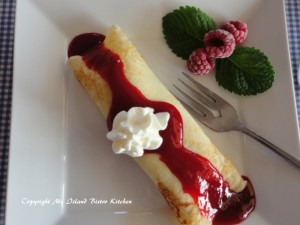
The lavender farm at the Five Sisters of Lavender Lane is located at 1433 Route 246 in Kelly’s Cross, PEI. Check out their website at http://www.fivesistersoflavenderlane.com/ or call them at 902-658-2203.
Thank you for visiting “the Bistro” today. There are lots of ways to connect with “the Bistro” through social media:
Join My Island Bistro Kitchen on Facebook
Follow the Bistro’s tweets on twitter @PEIBistro
Find the Bistro on Pinterest at “Island Bistro Kitchen”
Follow along on Instagram at “peibistro”
Lavender-Honey-Vanilla Ice Cream
By Published: August 9, 2012
- Yield: Apx. 1 quart
Lavender-infused homemade ice cream
Ingredients
- 1 cup whipping cream
- 1 cup half-and-half
- 1 cup whole milk
- 1/2 cup honey
- 2 tbsp caster sugar
- 3/4 tsp edible lavender flower buds
- 4 egg yolks
- 1/8 tsp salt
- 1/2 vanilla bean split and seeds scraped
- 1 tsp pure vanilla
Instructions
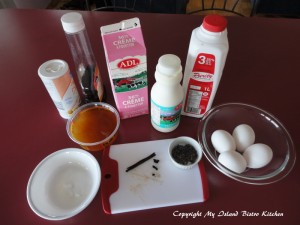 In double boiler, over medium heat, heat the whipping cream, half-and-half, milk, honey, sugar, lavender, and vanilla beans and pod. Stir occasionally and heat mixture until small bubbles start to appear around edge of mixture, about 10-12 minutes.
In double boiler, over medium heat, heat the whipping cream, half-and-half, milk, honey, sugar, lavender, and vanilla beans and pod. Stir occasionally and heat mixture until small bubbles start to appear around edge of mixture, about 10-12 minutes.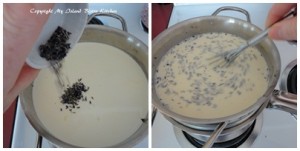 Remove from heat, cover, and let steep for 30 minutes to allow the lavender flavour to infuse the warm milk mixture.
Remove from heat, cover, and let steep for 30 minutes to allow the lavender flavour to infuse the warm milk mixture.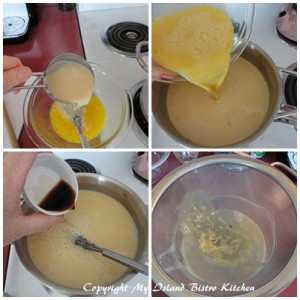 Strain mixture through a fine mesh sieve into a clean bowl. Discard remains in sieve and return strained mixture to a clean double boiler and heat to the scalding point, stirring to prevent the mixture from curdling or sticking to the bottom of the pot.
Strain mixture through a fine mesh sieve into a clean bowl. Discard remains in sieve and return strained mixture to a clean double boiler and heat to the scalding point, stirring to prevent the mixture from curdling or sticking to the bottom of the pot.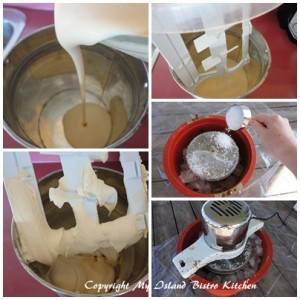 In a medium-sized bowl, whisk egg yolks and salt together. Whisk in vanilla. Add ¾ cup of the hot milk mixture to the eggs and whisk to blend. Pour this mixture into the custard in the double boiler. Cook over medium heat, stirring constantly until mixture thickens to consistency that it will coat the back of a wooden spoon. Do not boil. Be patient as this takes time.
In a medium-sized bowl, whisk egg yolks and salt together. Whisk in vanilla. Add ¾ cup of the hot milk mixture to the eggs and whisk to blend. Pour this mixture into the custard in the double boiler. Cook over medium heat, stirring constantly until mixture thickens to consistency that it will coat the back of a wooden spoon. Do not boil. Be patient as this takes time.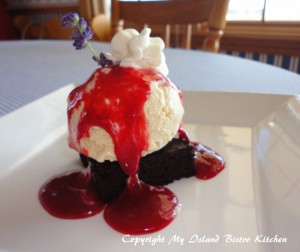 Strain mixture through sieve into a clean bowl. Cool completely then chill, covered, in refrigerator for at least 3 hours or more (can be chilled up to 24 hours). Freeze custard in ice cream maker according to manufacturer’s directions. Transfer ice cream to an airtight container and place plastic wrap directly on the surface of the ice cream. Cover and place in freezer for at least 4-6 hours to harden completely.
Strain mixture through sieve into a clean bowl. Cool completely then chill, covered, in refrigerator for at least 3 hours or more (can be chilled up to 24 hours). Freeze custard in ice cream maker according to manufacturer’s directions. Transfer ice cream to an airtight container and place plastic wrap directly on the surface of the ice cream. Cover and place in freezer for at least 4-6 hours to harden completely.
WordPress Recipe Plugin by ReciPress

